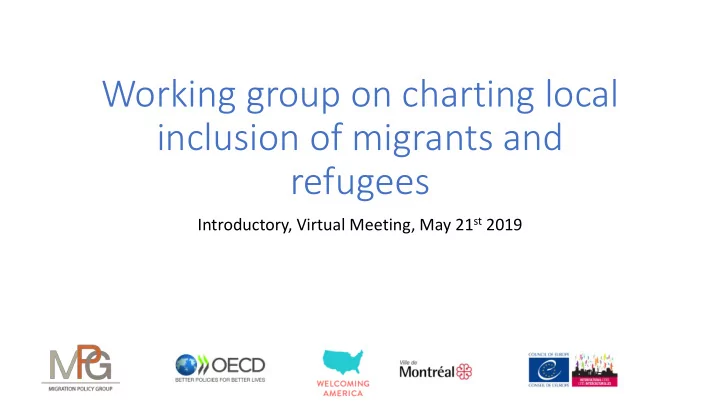

Working group on charting local inclusion of migrants and refugees Introductory, Virtual Meeting, May 21 st 2019
Outline For This Call 1. Describe the Origins, Purpose and Importance of this Initiative 2. Discuss Proposed Role of the Working Group on Charting Local Inclusion 3. Detail the Methodology for the Draft Tool 4. Discuss the Proposed Process for Moving Forward Together 2
I. The Origins, Purpose and Importance of this Initiative 3
Connecting the Local to the Global: the Gap We’re Helping to Fil ill • Cities and towns……. • Are at the forefront of migrant and refugee inclusion worldwide, but lack a shared, global set of KEY actions to move their work forward collectively. • Are eager to implement local elements of the Marrakech declaration, GCR and GCM, as well as related SDGs; but lack a common tool to chart their direction and measure their progress. • Lack common indicators to measure local inclusion, and metrics that can facilitate greater peer-to-peer learning and identify capacity building needs. • Lack a tool to track the implementation AND IMPACT of these actions 4
A Tool Derived From Cities, , For Cities • CITY BUY-IN ALREADY EXISTS: cities have expressed willingness to implement the CGR and CGM and have identified four priorities areas for their contribution in the Marrakech Declaration (Dec 2018) • Extensive KNOWLEDGE exists: a plethora of tools exist – deriving from cities themselves - focusing on what local authorities can do to make integration and inclusion effective • We analyzed relevant data and indicators from the following actors, all of whom represent - or work directly with – local authorities: Intercultural Cities Index - Council of Europe; Welcoming Standard – Welcoming America/International; OECD Working Together for Local Integration of Migrants and Refugees; UNHCR, Fundamental Rights Agency (FRA), UNICEF, UNESCO, WHO, Mediterranean City to City Migration (MC2CM), World Economic Forum (WEF), Centre for Mediterranean Integration (CMI), New American Economy (NAE), EUROCITIES, Global Compact on Migration, Mayoral Marrakech declaration • Together, we analyzed data and indicators from more than 500 towns and cities across the world 5
II. Proposed Role of the Working Group on Charting Local Inclusion……. That Means You! 6
III. Methodology for the Draft Tool 7
Building the tool (what we have done so far…) • Preliminary overview of the most important policy areas when it comes to integration of migrants and refugees at the local level • From the documents consulted: selection of keywords/(sub-)policy areas and related (feasible) actions • Verify their alignment to actions identified in the GCM, Marrakech declaration 8
Preliminary ry fi findings: TOP RANKING Keywords R Policy Area a RANKING Keywords/sub-policy areas Score n k political inclusion (of migrants) and consultation 12 1 Governance 81 mechanisms 2 Overall support for 40 data collection and management around migrant 12 migrants integration outcomes and policy 3 Employment (Access to) 32 Integration/Intercultural/Diversity plan/strategy 10 4 Education 25 Financing (Budget for integration-related initiatives) 10 5 Housing and Urban 16 Intercultural and language competences (staff) 10 Planning Communication 9 6 Welfare & Health 7 Cooperation with NGOs, private sector, etc. 9 9
How to PICK the language for the actions selected? Keyword/sub-policy area Matching Offer and Demand of labor at local level (score 4) Welcoming International A partnership program(s) is in place to support immigrant jobseekers with information, training and networking CMI Provide targeted training to refugee to match job offers CMI improve data on job offers OECD Improve matching between local labour needs and newcomers’ skills by building a locally accessible database of newcomers’ competences GCM Objective 5 Promote effective skills matching in the national economy by involving local authorities and other relevant stakeholders particularly the private sector and trade unions in the analysis of the local labour market, identification of skills gaps, definition of required skills profiles 10
Building the tool (what remains to be done…) • Verify their alignment to actions identified in the GCR, SDGs • Add Action plans from a number of cities (Montreal, etc.) • Select a small number of feasible core actions • Extract the most simple Wording 11
How to select the most relevant actions? • Current criterion : Frequency – how many actors analysed mentioned a sub-policy area • Possible criteria for selecting key policy (sub-)areas/actions during desk analysis – experts discussions: - Spreading: how many cities implement a given action? ..but data availability is very limited - Show progress: is this action easy to measure? -comparable data across different contexts- - Value Added of the measures suggested • Possible criteria for validating the key actions during roll-out of the tool at city level - Feasibility/Relevance in different Geographic Areas: consultation with policy makers in different regions (OECD/Non-OECD countries) to understand whether or not an action is feasible/relevant in their context • YOUR Feedback now, and in subsequent meetings, is essential 12
IV. Proposed Process for Moving Forward Together 13
Future development OF THE TOOL Cities Criteria to ROLL OUT Refinement Formulati select the in different buy- of policy on of the areas and geographic core actions sub-area s areas actions in Link the tool to City Working Group face to Networks (OECD, UCLG, face meeting (s) (first MMC, ICC, EUROCITIES, round in Marseille?) GPM, UNESCO,..) 14
Moving (fast) forward How can the tool support MMC, UCLG, EUROCITIES, etc in exploring cities Pledges Mechanism Data feed the STEP 0 (Dec Step 3 (from Step 1 (July Step 2 (Nov GCM/GCR local Peer to peer 2018-July 1st quarter 2019-1 st quarter 2019-Dec monitoring learning, cap. 2019): 2019): cities 2019): roll out 2020): buy-in Formulation of use the tool for building, etc i.e. IMRF, GRF, from cities for validation the tool data gathering etc Potential events for Connect the tool with Improve local leveraging buy-in: HLM, the Guidance Package inclusion GFMD Quito, UCLG Durban, GRF, ETC. 15
Thank You! We Look Forward to Continuing this Process Together!
Recommend
More recommend